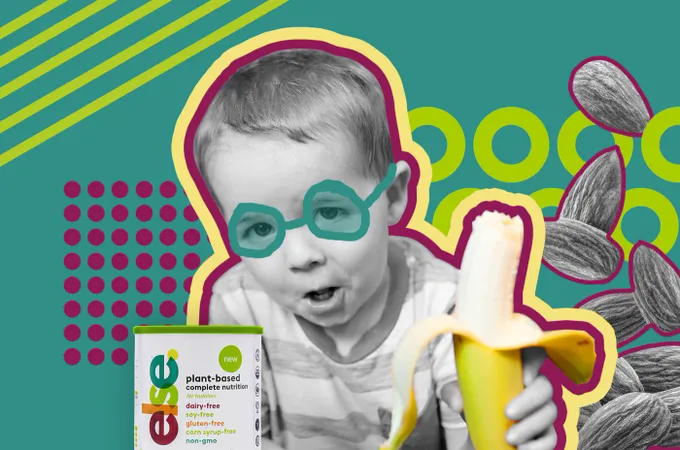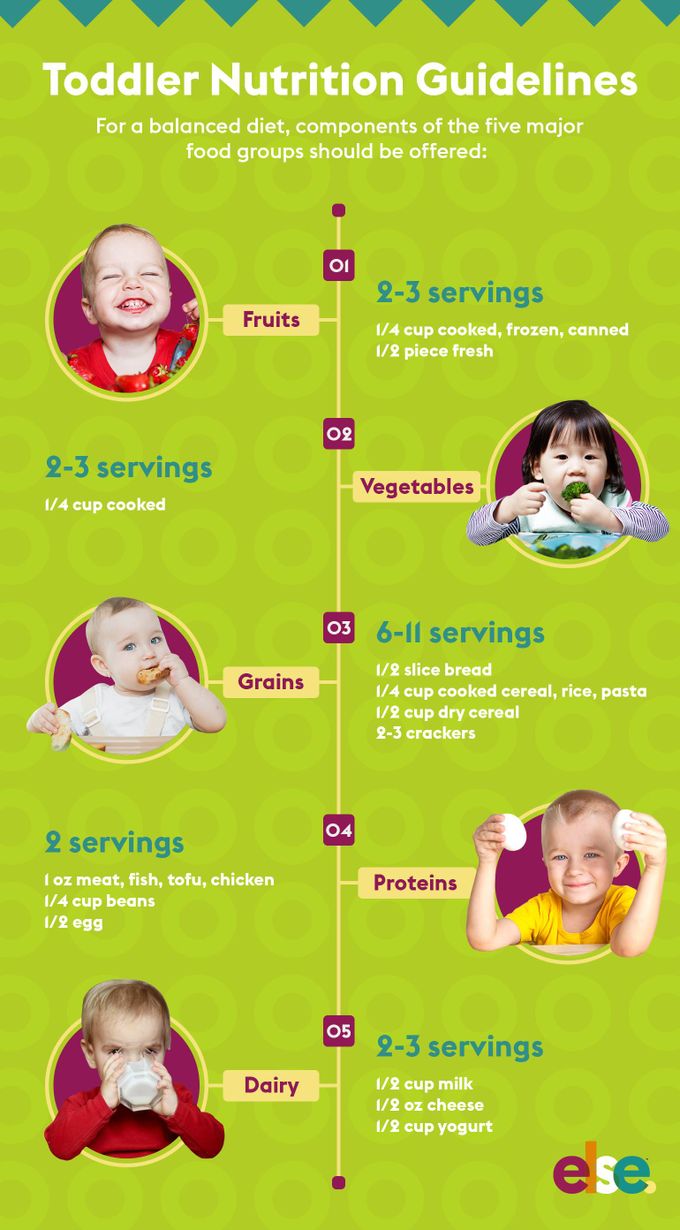What Toddlers Should Eat
Discover what toddlers should eat for optimal growth and development and learn more about balanced nutrition, key food groups, and healthy eating habits
Updated July 2, 2024

A busy 1 to 3-year-old has many interests that take priority over mealtime. These curious kids are exploring the world and finding ways to get into whatever is within their reach.
By the age of 12 months, most toddlers have graduated from “first foods” to mashed table ones. Infant formula is discontinued, and some infants are weaned from breastfeeding. Infant food restrictions no longer apply, but there are food safety concerns unique to this age group.
This is usually when parents notice changes in their toddlers' eating habits and preferences. Toddlers' nutritional needs pose the challenge of finding the right balance of nutrients while providing age-appropriate foods.
» Opt for plant-powered nutrition for a healthier start for your little one
Understanding Toddler Eating Habits
Some toddlers will drink as much milk throughout the day as a parent or grandparent will offer. In extreme cases, some drink over 40 oz of milk per day! These toddlers are so “full” from milk that they refuse food at mealtimes. There are other situations where the toddler prefers select foods. For example, a two-year-old may “love fruit, pasta, and pizza” but cry or have a tantrum at the sight of a vegetable on the plate.
» Toddler is refusing to drink milk? Here's how to encourage your kid to drink milk and get the necessary essential nutrients
Other toddlers are “grazers, snacking throughout the day instead of eating set meals. And then, there are the lucky parents whose toddlers eat all varieties of foods without protest. With so many barriers to consuming a balanced diet, it is important to be aware of what toddlers need for overall health.
» Find out more about toddlers' healthy eating habits
Toddler Nutrition Guidelines
Several medical authorities have presented guidelines for toddler nutrition in an effort to promote optimal growth and development.
- The American Academy of Pediatrics (AAP) recommends 1000 calories per day for one to three-year-olds (source).
- The World Health Organization (WHO) provides additional guidance on dividing these calories into 3-4 meals and 1-2 snacks daily (source).
For a balanced diet, components of the five major food groups should be offered:
| Fruits | 2-3 servings | 1/4 cup cooked, frozen, canned 1/2 piece fresh |
| Vegetables | 2-3 servings | 1/4 cup cooked |
| Grains | 6-11 servings | 1/2 slice bread 1/4 cup cooked cereal, rice, pasta 1/2 cup dry cereal 2-3 crackers |
| Protein | 2 servings | 1 oz meat, fish, tofu, chicken 1/4 cup beans 1/2 egg |
| Dairy* | 2-3 servings | 1/2 cup milk 1/2 oz cheese 1/2 cup yogurt |
» Make mealtime easier with yummy plant-powered nutrition
*For children with a milk allergy or who have celiac disease, authorities recommend soy milk and gluten-free grains (source). Soy milk is their preferred alternative until the age of two because of the higher fat and protein content compared to other non-dairy options.
» Learn how to identify soy intolerance symptoms
Busy parents who view these guidelines may cringe at the idea of measuring food for each meal; it is just too daunting a task. Stanford Children’s Hospital offers an easier way—a toddler's meal should be ¼ the size of an adult's portion (source).
Toddler Eating Patterns and Safety Guidelines
Parents should also remember that it is perfectly normal for toddlers to eat large amounts of food some days and less on others. The average amount consumed, however, should be consistent.
» Explore more about healthy foods for toddlers
The mechanics of eating can be difficult for toddlers, so modifications are necessary to make foods easier and safer for them.
By the age of 12 months, most toddlers have at least two front teeth. This allows for biting of foods but not much help with chewing. Molars begin to erupt around 14 months old, and teething continues until after the second birthday—and sore gums can make eating uncomfortable.
Most foods offered to young toddlers should have a soft texture and be cut into bite-sized pieces. The chewy textures of meats and poultry are more difficult for some toddlers to tolerate, causing them to reject these foods. Ground or pureed versions of meats are better tolerated.
» Here's how to feed your toddler
In addition to this, some foods are choking hazards for toddlers.
- Smooth-surfaced foods like small round fruits and hard candies can easily lodge into a toddler’s airway. To avoid this, any fruit the size of or smaller than a cherry should be cut into quarters before serving.
- Hotdogs and similar foods with skins or casings are equally hazardous. The casings should be removed, and the meat should be cut into bite-sized pieces.
- “Gummies” have become very popular food items among children and are used for fruit snacks, candies, and even vitamins. Unbeknownst to many parents, their sticky texture is both a choking hazard and a dental cavity risk.
Certain foods are considered unsafe for infants prior to 12 months due to the risk of certain infections. Honey, in particular, is a risk for botulism. Over the age of 12 months, however, most medical authorities feel that the digestive system has matured enough to handle any possible exposure (source). Unpasteurized foods should still be avoided, and food should be prepared and stored at proper temperatures (source).
» Check out these yummy, quick, and nutritious recipes for toddlers
Foods to Offer and to Avoid
The nutritional needs of toddlers differ from those of older children. It is especially important for them to obtain adequate vitamin D and calcium for optimal growth. Although the WHO recommends breastfeeding at least until the age of two, this is not practical for every family (source). Fortified milk and soy can provide calcium and vitamin D. Care should be taken, however, not to exceed more than 20 oz of milk per day, which can cause constipation and anemia.
Iron and healthy fats are important for brain development until the age of two. Full-fat dairy, nuts, coconut oil, salmon, and avocados are great sources of healthy fats. Food sources of iron include beans, lentils, meats, eggs, tofu, and spinach (source).
» Discover how to include more healthy fats into your kid's diet
After age two, the AAP recommends low-fat, low-cholesterol foods. Processed foods should be avoided due to their high salt and sugar content. Kids don’t need this extra salt, and sugary foods and drinks contribute to obesity and tooth decay (source).
» Check out our guide on understanding calorie needs of toddlers
So, What ELSE?
To assist parents in providing their toddlers with the recommended nutrients, the developers of Else have created plant-powered Else Toddler Nutrition. Else organic, plant-powered nutritional formula is made from almonds, tapioca, and buckwheat. It contains a variety of vitamins and minerals, especially the calcium, vitamin D, and iron that toddlers need and may fail to get regularly in their diets. Consistent with the AAP recommendations,
Else formula is low in sugar and salt. It is a “clean ingredient” product that is less processed than other options on the market and contains no hormones or preservatives. For all of these reasons, Else can be beneficial for many toddlers.
The content and advice provided in this article are for informational purposes only and are not a substitute for medical diagnosis, treatment, or advice for specific medical conditions. Always consult a pediatrician to understand the individual needs of your child.











